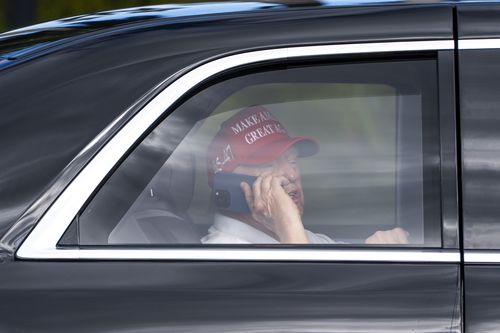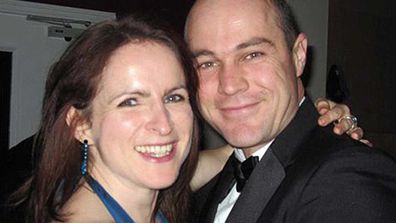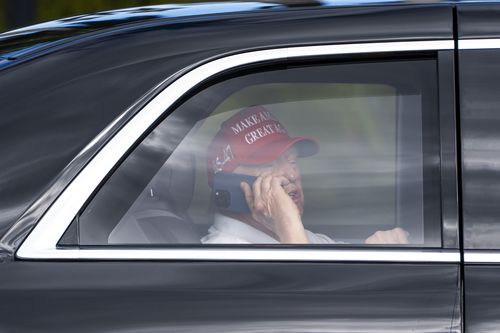Share this @internewscast.com
President Donald Trump’s sweeping new tariffs are encountering backlash from all directions – a market sell-off, foreign retaliation, displeasure from corporate America, and skepticism from the Federal Reserve chairperson and some of his congressional allies. Nevertheless, the president remains resolute amidst the global unrest.
Amid mixed messages from Trump and top administration officials over the past day and a half on whether the tariffs signify the beginning of negotiations or a more lasting shift in US economic policy, Trump did not seize Friday as an opportunity to clarify. He did not step onto the factory floor of an American business to sell his plan or highlight a business or community he believes will gain from the tariffs.
Instead, the president chose to begin his day on the golf course in Florida.

Corporate America, meanwhile, is irate, according to conversations with a dozen chief executive officers.
Treasury Secretary Scott Bessent has been receiving indignant calls from executives, some considering legal action against the administration over the tariffs and the national emergency Trump claims justifies them. A stronger-than-expected jobs report on Friday, one executive told CNN, should be presented to a judge in case of litigation as additional evidence that no such national emergency exists.
Companies have been reticent to attack the administration’s policies in court or on the airwaves for fear of rhetorical attacks – or worse. When one company suggested privately to Trump officials that their proposed tariffs would simply raise prices on goods with no effect on their factory locations, the official suggested they would double the tariff to get the company to move.
Bessent is among the many Trump officials who had been advocating for a more nuanced approach to tariffs than what Trump unveiled, a policy that was immediately met with skepticism for how it was engineered.
After the rollout – and a round of interview with major television networks – the newly minted Treasury secretary found himself in awkward company as he joined a reunion dinner at Café Milano with most former Treasury secretaries – a bipartisan tradition going back decades. ”Liberation Day,” according to sources, quickly became the subject of conversation, though the scheduling was unintentional.
A second CEO close to the White House says the breadth and extremity of the president’s tariff policy was shocking, especially considering how many companies have already adjusted their businesses to align with Trump’s perceived policy goals.
“It was his first administration that caused [manufacturers] to move from China to Vietnam,” the CEO said. “Now, we’re punishing them, too. There’s no endgame.”

Suspicions raised after skydiver falls 1200m and survives
Trump trained his anger on China during his first term, leading many manufacturers like Nike, Gap, Levi’s, and Dell to begin shifting operations to Vietnam, in order to save costs and set up shop in friendlier territories. But now Trump is hitting Vietnam with a 46 per cent tariff, leaving many executives exasperated – and planning to raise prices rather than relocate yet again.
In the words of another executive: “We’re just going to have to make fewer shirts and sell them for more money.”
Despite objections from many within his Cabinet over unnecessarily angering allies and ratting global markets, Trump’s views on tariffs are ossified – and amplified by his close counselor Navarro. Feedback from dissenters has fallen on deaf ears.
“The problem is, it’s the president’s view and it’s not widely shared,” said the executive close to the White House of Trump’s commitment to lowering trade deficits. “On this issue, he seems immovable.”
On Wall Street, group chats on messaging apps have lit up over how or whether to publicly speak out against a president who has shown a penchant for retribution. Other private sector executives are debating whether to hire a Trump-friendly lobbyist to try to seek an exemption from the policy.
A desire to refocus on tax cuts
After weeks of internal debate over the reciprocal tariffs – and frequent mention by the president of his love for the tool – many of his allies have grown weary of discussing them and feel it’s time to turn attention to his tax plans.
In part, that is because they believe the tax cuts – particularly eliminating taxes on tips and overtime, both promises he made as a candidate – are easier to understand and more of a political winner than the tariffs, which are complicated and run the risk of raising prices.
That tax plan is still a work in progress on Capitol Hill, where narrow majorities and divergent policy views have already bubbled up during negotiations over the procedural mechanism that will be used to move it through the House and Senate on a partisan basis.
But the effort needed from Trump’s economic team to both put in place historic tariffs and get a tax bill over the finish line also spilled into the internal scramble leading up to Trump’s announcement as advisers grappled with whether to use some kind of universal baseline tariff or setting a country-by-country number that captured a measurement trade economists in both parties panned as nonsensical.
On Monday, Trump asked for the list that would form the basis of the Rose Garden chart he would hold up. Throughout, two of Trump’s top advisors shuffled up and down Pennsylvania Avenue to negotiate with congressional Republicans over the pathways to their critical tax proposal.
National Economic Council Director Kevin Hassett, who had successfully made the case for reciprocal tariffs to Trump for months, and Bessent, were also running point on the tax efforts. They provided little intel on tariffs to desperate Republicans on the Hill during their visits.
But in their absence, two of Trump’s most strident tariff supporters – Navarro and Lutnick – helped shape where Trump would ultimately land.














